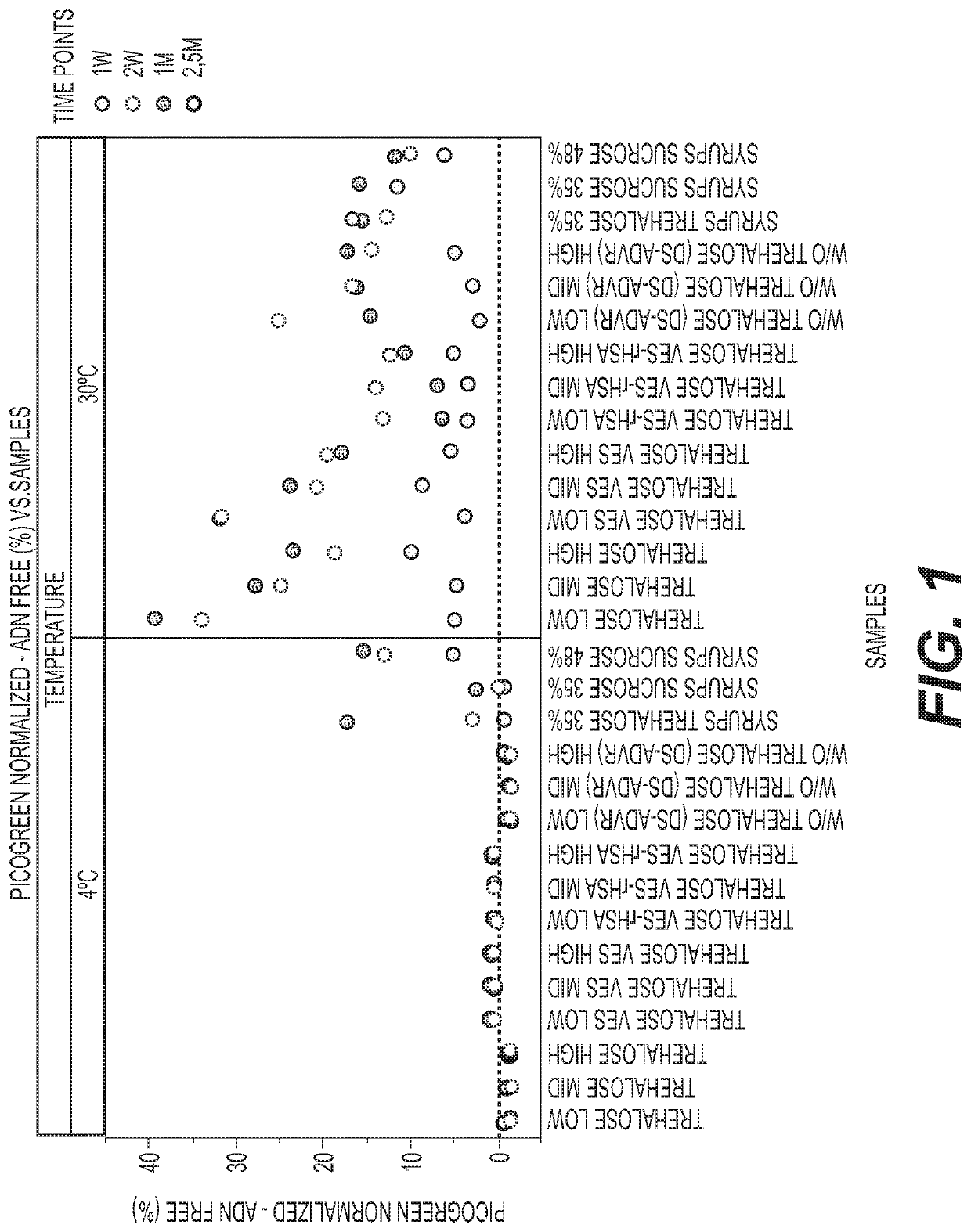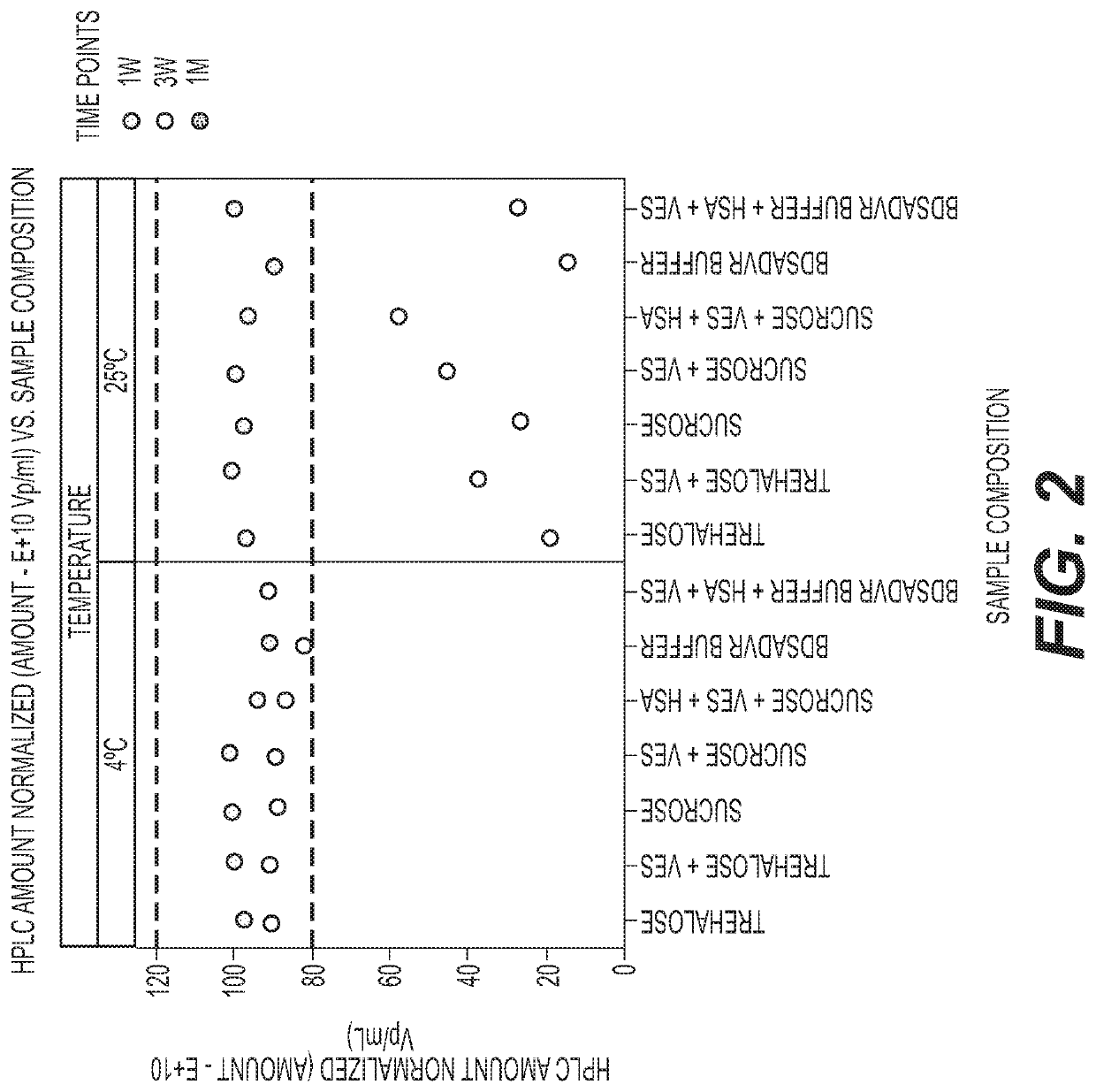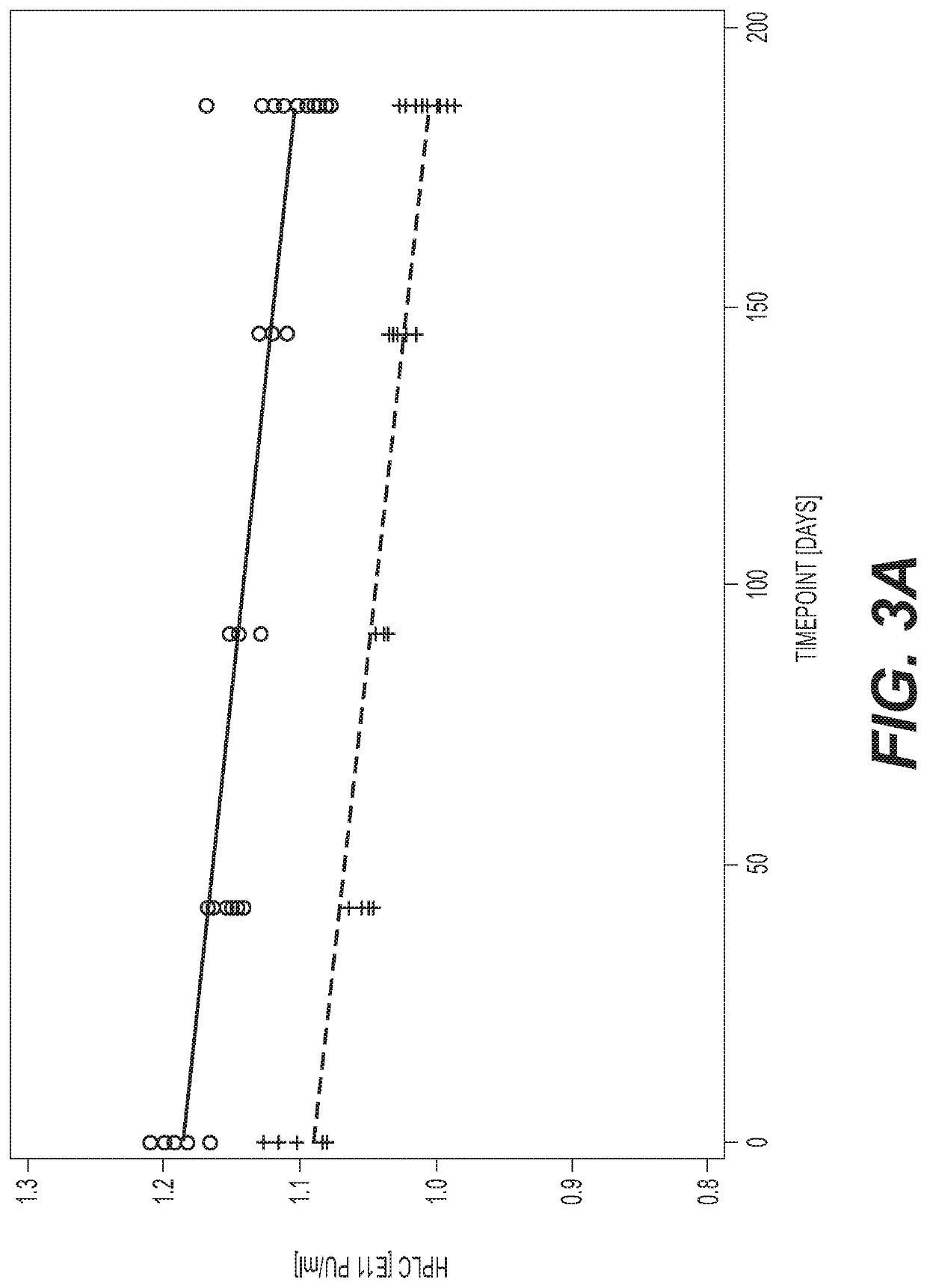Formulations for simian adenoviral vectors having enhanced stability
a technology of simian adenovirus and vector, which is applied in the field of simian adenovirus vector formulation, to achieve the effect of increasing the stability of simian adenovirus
- Summary
- Abstract
- Description
- Claims
- Application Information
AI Technical Summary
Benefits of technology
Problems solved by technology
Method used
Image
Examples
example 1
Testing of the Effects of Excipients on Stability
[0094]ChAd155-RSV (WO 2016 / 198599) was formulated at a concentration of 1×1011 virus particle units per milliliter (“pu / ml”) in 10 mM Tris pH 8.5, 25 mM NaCl, 8% sucrose (w / v), 0.02% polysorbate 80 (w / v) and 1 mM MgCl2, then tested for stability after being exposed to temperatures of 30° C. for three days or seven days. Five excipients were tested in a 25-1 fractional factorial design study having five factors (the excipients) with 16 runs in the corners and four center points. The factors were (1) MgSO4 at a concentration of 15 mM or 30 mM; (2) ethanol at a concentration of 1.54% or 3.07%; (3) TRAVASOL at a concentration of 1 mM or 4 mM; (4) rHSA at a concentration of 0.05% or 0.5%; and (5) Vitamin E succinate (VES) at a concentration of 1 mM or 2 mM. Stability was determined by measuring viral particles by analytical HPLC. The ability of the virus to retain infectivity was measured as the number of cells expressing the adenovirus he...
example 2
Sugar Composition, Osmolality, VES and rHSA on Stability and Infectivity
[0098]ChAd155-RSV was formulated at a concentration of 1×1011 pu / ml comprising a 10% overage in Tris pH 8.5, NaCl, polysorbate 80 (w / v), histidine, MgCl2, trehalose, sucrose, rHSA and VES at concentrations shown in the table below for the first twelve compositions. Compositions 13-15 were formulated at 2× concentration to test the concept of a syrup and were then diluted prior to analysis.
¶¶¶¶¶¶¶¶¶¶¶¶¶¶¶¶rHSA¶¶¶#¤Adenovirus¤Tris•pH 8.5•(mM)¤Histidine•(mM)¤NaCl•(nM)¤MgCl2•(nM)¤Polysorbate•80•(%•w / v)¤Trehalose•(%•w / v)¤Sucrose•(%•w / v)¤(%•w / v)¤VES¶ (mM)¤Osmolality•(mOsm)¤ 1¤1.1 ×10¤10¤ 5¤1¤0.020¤ 7 (low)¤ 2¤0¤0¤ 325¤1011¤ 2¤1.1 ×10¤10¤ 5¤1¤0.020¤15 (mid)¤ 2¤0¤0¤ 616¤1011¤ 3¤1.1 ×10¤10¤ 5¤1¤0.020¤23 (high)¤ 2¤0¤0¤ 584¤1011¤ 4¤1.1 ×10¤10¤ 5¤1¤0.024¤ 7 (low)¤ 2¤0¤ 0.5¤ 333¤1011¤ 5¤1.1 ×10¤10¤ 5¤1¤0.024¤15 (mid)¤ 2¤0¤ 0.5¤ 640¤1011¤ 6¤1.1 ×10¤10¤ 5¤1¤0.024¤23 (high)¤ 2¤0¤ 0.5¤ 1013¤1011¤ 7¤1.1 ×10¤10¤ 5¤1¤0.024¤ 7 (l...
example 3
Trehalose, Sucrose, VES and rHSA on Stability at 4° C. or 25° C.
[0101]ChAd155-RSV was formulated as shown in the table below. Each formulation was tested for stability by analytical HPLC after being exposed to temperatures of 4° C. or 25° C. for three weeks to examine the effects of trehalose, sucrose, VES and rHSA on stability.
PolysorbateTrehaloseSucroserHSAAdenovirus TrisHistidineNaClMgCl2(%(%(%(%VES(pu / ml)(mM)(mM)(mM)(mM)w / v)w / v)w / v)w / v)(mM)11.1 × 10111010510.024720021.1 × 10111010510.0247200.0531.1 × 1011100510.024080041.1 × 1011100510.0240800.0551.1 × 10111010510.024080.10.0561.1 × 101110102510.024080071.1 × 101110102510.024080.10.05
[0102]The virus was maintained at 4° C. for three weeks (left panel) and at 25° C. for at least one week (right panel) in each of the tested formulations (FIG. 2). After one week at 25° C., no degradation was observed. After three weeks at 25° C., some degradation began to occur and the differential effects of the formulation components were able to...
PUM
| Property | Measurement | Unit |
|---|---|---|
| Temperature | aaaaa | aaaaa |
| Temperature | aaaaa | aaaaa |
| Temperature | aaaaa | aaaaa |
Abstract
Description
Claims
Application Information
 Login to View More
Login to View More - R&D
- Intellectual Property
- Life Sciences
- Materials
- Tech Scout
- Unparalleled Data Quality
- Higher Quality Content
- 60% Fewer Hallucinations
Browse by: Latest US Patents, China's latest patents, Technical Efficacy Thesaurus, Application Domain, Technology Topic, Popular Technical Reports.
© 2025 PatSnap. All rights reserved.Legal|Privacy policy|Modern Slavery Act Transparency Statement|Sitemap|About US| Contact US: help@patsnap.com



